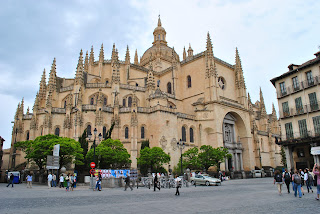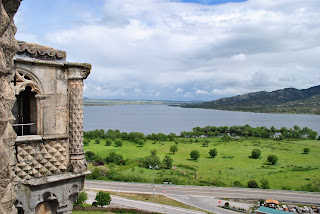This weekend we hit up a few different places: Segovia, El Escorial, and Manzanares. But first, the rest of the week. I did return to El Palacio Real and take a little tour inside (it’s free on Wednesdays!). This is the Royal Place of Madrid. We weren’t technically supposed to take pictures, but my finger must have slipped a few times so I could get a couple. What great luck!
 |
| This room is made almost entirely of porcelain. |
 |
| We counted 80 chairs. That's quite the family. |
Other than this little excursion and the previous excursion (back up one post), not much else went down this week. Erin and I did go to Mari’s Flamenco class to watch them practice (just watching, no dancing on our part. I know, sad). Flamenco hails from Andalucía, in southern Spain. Next week our group will go see a professional Flamenco group, so stay tuned!
Now, back to this weekend. Friday, our little group ventured north to Segovia, a quaint little town set on a colina (hill). It’s home to the famous Roman Aqueduct, Catedral, and Alcázar of Segovia (not Genovia. No Princess Mia there). This city began as a station for Roman troops along the roads connecting Zaragoza and Mérida and eventually grew into a thriving little city.
More on the aqueduct. This thing is incredible. It was built in the 1st or 2nd century AD. It’s 16 kilometers long, took 20 years to build, and is made of about 25,000 large, granite stones, stacked together, WITHOUT mortar. That’s right. Not a single thing is holding this structure together, except gravity. It even withstood an earthquake. Now that is good workmanship. It’s no longer used, but when it rains or snows, water will still runs through it just fine.
Geez, the monuments of Segovia have taken quite the beating. La Catedral de Segovia was hit by a tornado, but it’s still standing too. This cathedral was built in the 1500s and is one of the last Gothic-style cathedrals built in Spain. The first cathedral in Segovia was destroyed in a war so this was built to replace it. The tornado did do some damage. There are cracks in parts of the ceiling and in some of the walls, and many windows on one side are broken. Currently, there is an ongoing project to restore these windows.
 |
| One of the windows being restored. |
 |
| It's hard to see the broken parts of the glass. Can you see some of the cracks in the walls? |
Ok, I have a riddle for you. What do Walt Disney and Segovia have in common?? I have no idea… just kidding! The castle here is the inspiration for Disney’s famous Sleeping Beauty castle (you have to use your imagination a little. Maybe if we had seen it from the other side...). Technically, this castle is an alcázar. Basically, the difference is this: all alcázares are castles, but not all castles are alcázares. In order to be an alcázar, the castle must be owned by a king. Any person with money could own a castle, but only a king could own an alcázar. This particular one was built in the 11th century and is the oldest in the Segovia province. It is also the very place where Christopher Columbus petitioned Kind Ferdinand and Queen Isabella to sponsor his voyage to the Americas in 1492. That’s a quite a bit of history sitting right here.
Our last stop in Segovia was this little church, La Iglesia de los Santos Justo y Pastor, built in the 12th century. It was opened especially for us. In one of the articles we read during the prep course, the author talked about this church and the murals inside, so we wanted to see it. These murals have been covered for hundreds of years by thick plaster, and there is major restoration work underway to uncover them. They depict the life of Christ and the history of the world, beginning with Adam and Eve. The final scene is left unfinished and the painter wrote that he was not able to finish the painting. Whether he was sick and dying, or the arthritis in his hands was too much, or he simply could not bring himself to finish the work, we will never know.
Day two. On to San Lorenzo de el Escorial and Manzanares el Real. We only went to two places in each city but it took us all day to see both; however, on our way to El Escorial we found that we were a little early so we took a side trip up to Francisco Franco’s tomb and monument, located in el Valle de los Caídos (valley of the fallen). The monument and Catholic basilica located below (Franco is buried in there), where mass is still held, were commissioned by Franco to honor those who fell in the Spanish Civil War. Franco was the fascist dictator of Spain who ruled from 1939 until 1975. These two structures, dedicated to Franco by himself, were made by slaves under his orders. So it’s difficult. They were made under terrible conditions, yet you can’t help but admire them. They’re beautiful. I figure it’s better to admire their beauty and workmanship, so the efforts of the slaves were not in vain. Like the pyramids. I have to admit though, I definitely felt like I was in Lord of the Rings. I felt like I was walking into the halls of the dwarf kings or something. It was pretty cool.
 |
| This is the tallest cross memorial in the world. |
Next stop, El Real Monasterio de San Lorenzo (whenever you see “Real” it means royal). This building is simply known as El Escorial. It combines a monastery, where 40 priests still live; the Palace of the Hapsburgs, the historical residence of the king of Spain; a mausoleum, where the remains of many kings and queens of Spain rest, and over 300 other tombs; a royal library; and a cathedral, which we didn’t get to see because there was a wedding. This building was built in the 16th century, has 16 towers, and over 2000 windows. The Hapsburgs are from Austria and ruled Spain from 1506 to 1700. Don Juan, a Spanish noble buried in El Escorial, wore 16 rings. Each ring represented a lover. And if a Spaniard is very handsome and suave, he is often called a Don Juan. There. That is all the interesting facts I gathered about El Escorial. It’s a beautiful, simple building and multi-functional!































Haha, I loved your seven-year-old self. It made me laugh :)
ReplyDelete